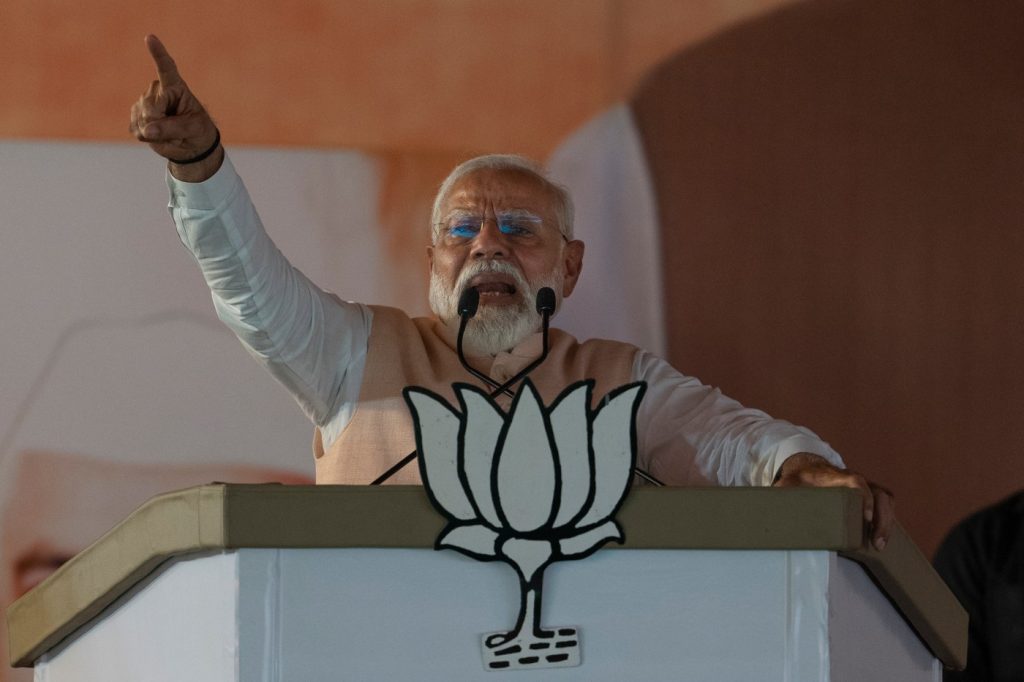By Swati Gupta and Dan Strumpf | Bloomberg
Prime Minister Narendra Modi’s ruling party is poised to lose its majority in parliament, forcing him to rely on allies to form a government. It’s a stunning blow to a leader who has dominated Indian politics since he first took power a decade ago.
Modi’s Bharatiya Janata Party was leading in 241 seats, short of the 272 needed to form a government and well behind the 303 it won in the 2019 election. The opposition bloc, known as the Indian National Developmental Inclusive Alliance, was on course to win more than 220 seats, the results showed.
Modi now needs to secure the support of two key members of his broader National Democratic Alliance who control some 30 seats — enough to flip the balance of power in parliament. Leaders of those two parties have a history of switching sides, and only joined up with Modi a few months ago, making it unclear whether they will stick with him or back the opposition bloc.
India’s NSE Nifty 50 Index tumbled 5.9%, its worst day in more than four years, as it became clear the election outcome would be much closer than expected. Stocks had hit a record high on Monday after exit polls released over the weekend showed Modi would coast to an easy victory in the marathon, six-week election. Before voting kicked off on April 19, he had boldly predicted that his alliance would win a whopping 400 seats.
“This is not an election — it is a kind of political earthquake,” said Niranjan Sahoo, senior fellow with the New Delhi-based Observer Research Foundation who has written several books on Indian politics. “Even if Modi becomes the prime minister, his position will be diminished to a great extent. He will not be the same Modi.”
The result is a disappointment for the 73-year-old leader, who has been the main face of the BJP’s election campaign and built the party primarily around himself. Besides raising questions about Modi’s own future as prime minister, a weak coalition government will likely make it difficult for him to push through tough economic reforms or further his Hindu nationalist agenda assuming he returns to power.
The lackluster performance marks the first major setback at national polls for Modi. He had looked unbeatable heading into the election, backed by one of the world’s fastest-growing economies and the fulfillment of key promises appealing to India’s Hindu majority, including the building of a temple on the site where a 500-year-old mosque had been torn down.
Related Articles
Exit polls: Narendra Modi headed for landslide reelection in India
India’s capital breaks heat record, officials impose water rationing
India votes in fifth phase of election including in city where PM opened controversial Hindu temple
Massive billboard collapses in Mumbai, killing at least 14
Modi escalates rhetoric against Muslims as India continues to vote
Yet more than 20 opposition parties, spearheaded by Rahul Gandhi, formed a united front in a bid to stop Modi’s once-dominant electoral machine. A mixture of regional and caste-based groups, the alliance focused on appealing to voters who felt left out of India’s growth story, which has been marked by growing inequality, pervasive joblessness, rising living costs and growing demand for welfare support.
Signs of trouble for Modi emerged after the first of seven rounds of voting. A dip in turnout triggered a broad get-out-the-vote effort that saw Modi adopt a more strident tone, firing up his Hindu nationalist base with divisive anti-Muslim rhetoric and attacks on the opposition’s welfare policies.
Modi had appealed to India’s 1.4 billion people with a combination of business-friendly policies, welfare measures for the poor and Hindu nationalist policies. He had pledged more of the same in his third term, vowing measures to create jobs while also replacing India’s religion-based marriage and inheritance laws with a uniform civil code — a measure that Muslims, Christians and other minorities oppose because it would prevent them from adhering to some faith-based laws.
Those more contentious proposals may now be off the table. The results also call into question whether Modi would have the political capital to implement contentious changes to land and labor laws, as well as a slew of other reform measures needed to achieve his goal of turning India into a developed nation by mid-century.
Even with a reduced mandate or a change in government, India’s growth trajectory should largely remain positive. Business leaders from Elon Musk to Jamie Dimon have hailed India’s potential as an alternative to China, with some economists projecting that the nation’s $3.5 trillion economy can become the largest contributor to global growth within the next five years.
“Political stability has been at the very core of both economic growth and investor sentiment over the last decade,” said Sumeet Abrol, a partner at business consultancy Grant Thornton Bharat. “The verdict of the world’s largest democracy will put decisive leadership to reforms to a test the markets haven’t seen in the last decade, leaving investor sentiment exposed to cautiousness and volatility in the near term.”
More stories like this are available on bloomberg.com
©2024 Bloomberg L.P.


